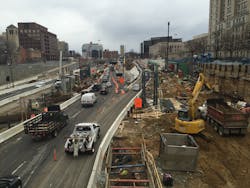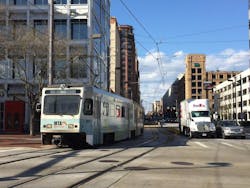Where transportation fits in with city priorities
It’s interesting that of all the issues stacked on the plates of U.S. city mayors these days – including rising crimes rates and the recent spate of cop killings, which will no doubt further inflame racial tensions – economics wins out.
Frankly, that’s not surprising, for economic growth is a major curative for a lot of what ails humankind, especially poverty, as this report explains.
Thus for the third consecutive year, economic development remained the top issue for the nation's mayors, according to a new report compiled by the National League of Cities (NLC).
That being said, the group’s 2016 State of the Cities report – which examines so-called “state of the city” speeches in 100 urban locales across the U.S. representing a diverse cross section of population sizes and geographic regions – found that while “economic development” came out on top at 75%, the issue of “public safety” replaced “infrastructure” as the second most-discussed issue (70%), followed by “city budgets” at 52%.
"Mayors are focusing on innovative strategies to grow jobs, modernize manufacturing and keep our residents safe,” noted Clarence Anthony, NLC’s CEO and executive director, in a conference call late last week.
“But we must work hard to address critical challenges – including inequality, gun violence, inclusion issues, and dilapidated infrastructure –for our cities, and our nation, to thrive and succeed."
Here are a few of the major “city trends” highlighted in the NLC’s study:
- Mayors continue to focus on improving their local economies and encouraging entrepreneurship.
- Mayors are seeing improved revenue and are being judicious about how to spend it.
- Mayors are cautiously optimistic about the future and are leading in the development of sustainable communities where people want to live.
- Mayors are concerned about the uptick in the murder rate even though overall crime rates are historically low.
- Mayors are concerned about the increasing opioid epidemic.
- Mayors are helping their cities see the value of using technology and data to drive decisions and make their city governments more efficient and effective.
Though infrastructure – and its major subset, transportation – is not as big an issue this year as it’s been in the past, worries about roads strongly persist. Here for example are the top five infrastructure “subtopics” highlighted by NLC’s research:
- Roads: 48%
- Bikes: 32%
- Sewers: 23%
- Internet/Broadband: 22%
- Buses: 18%
The focus on roads is critical as more and more city mayors want their urban locales to become more “manufacturing friendly,” and manufacturing needs good road networks (among other modal connections) to support its logistical needs.
The same holds true for what’s being dubbed the “maker movement” comprised of tinkerers, independent inventors and designers, and other “niche” manufacturers, in the words of Mayor Joseph Curtatone of Somerville, Massachusetts.
“Small, independent businesses from craft brewers to design firms, bakeries, and salons are popping up all along our streets and in our squares,” he said in NLC’s report.Helping those kinds of businesses grow includes making “linkages” between makers, the technology sector and local manufacturers, added Mayor John Tecklenburg of Charleston, South Carolina
“More and more cities are making it easier for entrepreneurs to apply for the permits and licenses needed to start or grow a business,” he said. “We will be expanding our online offerings for business—where now, for the first time ever, business licenses can be acquired through our city’s website, and soon, the entire building permit process will be available in a single, seamless online system.”
Mayor Andrew Ginther of Columbus, Ohio, added another interesting wrinkle: the “small business concierge” that in his words will “help entrepreneurs navigate city government” along with what he calls “the ‘Small Business Builder,’ an online roadmap for each stage of starting or expanding a business.”
Will up-and-coming trucking firms be allowed to tap into any of those resources? That remains to be seen. But they might be needed, especially as freight demand is expected to soar in the coming decades, according to Anthony Foxx, the U.S. Secretary of Transportation
“As our ‘Beyond Traffic’ study released last year indicates, it is estimated that by the year 2045 freight volume will grow to 29 billion tons—an increase of 45% from 2014 levels,” he explained during testimony in June before the U.S. Senate. “The freight programs in the FAST Act now provide, for the first time, dedicated federal funding that will allow us to fund freight and highway projects, including multimodal projects, to deal with these growing needs.”
We’ll see how freight and trucking fit into city planning priorities as the months progress.

